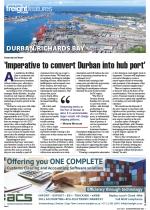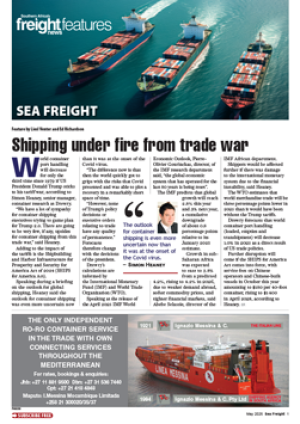Major inroads have been made to address ongoing congestion at the Port of Durban – an issue that was so critical that the president had to step in. Less than two years ago Transnet Port Terminals (TPT) was under severe pressure, with traffic congestion inside and outside the port reaching exceptionally high levels, while labour issues such as a go-slow were heavily impacting operational performance.“We faced some very real challenges in the months before the Covid-19 pandemic broke out,” said Moshe Motlohi, Port of Durban port manager. “Employee morale was low, there were limitations on people resources, equipment availability and reliability was problematic, and the Transnet IT infrastructure was in a poor state.” Fast-for ward 18 months and one pandemic later and the port is thriving.“ We are by no means where we need to be,” said Motlohi. “We have, however, started the journey and we are seeing progress all the time.” The successful turnaround is attributed to the multi-stakeholder task team approach taken by Transnet. “The transformation at the port is a testimony to what can be achieved with a collaborative approach. We realised the port was bleeding and stopping that was a priority. We also realised we would need the input and assistance of the various stakeholders. We were not going to stop the bleeding by ourselves.” He says the development of the task team enabled Transnet National Ports Authority (TNPA) to identify the real issues facing port users. “The concerns of the private sector were well articulated, but more importantly, through the task team they were on board to assist in finding solutions that would address the inefficiencies.Motlohi does not beat around the bush and says towards the middle of 2019 there was absolute chaos in the port at times. “Truck drivers were doing what they wanted, there were no police or metro officials on-site to assist, staff morale was very low, and operational productivity had dropped. We were battling equipment shortages and putting out fires on all fronts.” The identification of several workstreams by the task team brought about the much-needed change.“The top priority was the congestion response and enforcement workstream followed by the TPT operational performance improvement workstream. The engagement and involvement of all port stakeholders brought about real solutions on the ground.” Today, the situation at the port is very different, despite the impact of the global pandemic.“No, we are not yet at the world benchmark standards, but we have seen a serious improvement in this port and continue to do so every day.” According to Motlohi, the introduction of a truck booking system has brought about change. He praises the willingness of other terminal operators in the Port of Durban to share resources and to embrace the collaborative spirit as part of the success of the task team.“ FPT, for example, had an off-site staging area and during their off-season allowed others to use their facilities, allowing for a lot of the traffic inside the port to be smoothed.“ We have also improved the crane moves per hour from 46 in 2019 to the current 49. We want to see this increase as well going forward.” Other improvements made were to the berthing delays. Where ships previously spent an average of 63 hours waiting at anchorage for Pier 1 and 94 hours for Pier 2, the latest reports indicate a waiting time of only 34.6 hours at present.“ Equipment has been a problem in the port for a long time. In 2019 real delays were experienced, with only 52 straddles available for operations at the Durban Container Terminal (DCT). TPT also needed to replace 45 straddles that had passed their life expectancies.” The terminal has, within the past year, increased straddle availability to 73 per day, while 22 of the 45 straddles have been replaced. A further 23 are in the procurement process. But possibly the biggest change at the port has been truck waiting times. “A year ago some trucks could wait for as long as 21 hours to enter the port. The average waiting time today is only 86 minutes outside the port,” said Motlohi. Possibly the biggest change at the port has been truck waiting times.– Moshe Motlohi“

